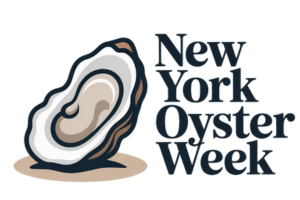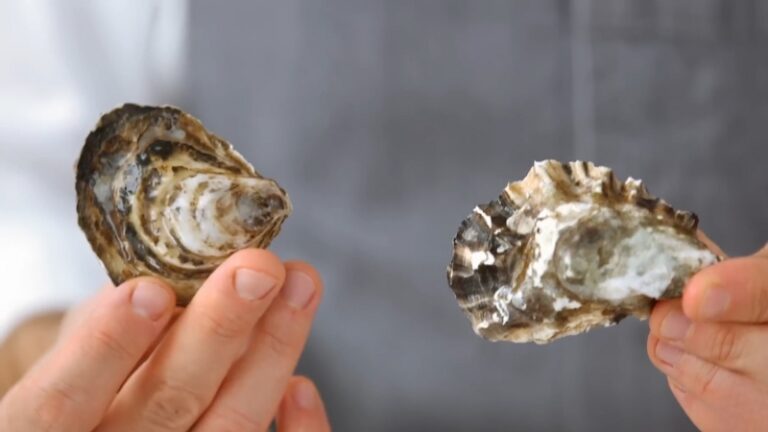There’s something almost primal about slurping a fresh oyster straight from the shell. The cool brine, the sea-scented aroma, the texture that walks the line between silk and bite. But where that oyster comes from makes all the difference.
Across the United States, the two coasts have spent generations shaping their signature shellfish: the East and the West. And if you ask longtime oyster lovers where the best ones come from, you’ll often hear three words: New York wins.
Let’s take a close look at why.
The Ocean Shapes the Oyster
An oyster is a mirror of its environment. The concept of merroir – similar to terroir in wine – is the idea that an oyster’s flavor reflects the salinity, temperature, minerals, and even microbial makeup of the waters it filters.
That means the Atlantic and Pacific Oceans each raise oysters with entirely different personalities.
East Coast Oysters
The Atlantic breeds a particular kind of oyster – salty, savory, and layered with depth. The colder water slows growth, sometimes stretching the life cycle out to four years or more.
That slow pace translates to more time for flavor to develop. You’ll often get a salty burst up front, followed by clean minerality or a subtle vegetal edge. It’s a flavor that sticks with you.
Notable East Coast varieties include:
- Pemaquid (Maine): A compact oyster with a sweet-briny balance, perfect for those new to raw oysters.
- Wellfleet (Massachusetts): Punchy brine and a sweet finish, known for its robust flavor.
- Misty Point (Maine): Clean, crisp, with a touch of salt.
- Maine Belon: Metallic and delicate, often appreciated by veteran oyster fans.
The salt levels are no joke. The Atlantic is a saltier ocean, which directly impacts how East Coast oysters taste.
You’ll know what’s coming the moment the shell hits your lips – big flavor, firm texture, and that unmistakable ocean zing.
West Coast Oysters
West Coast oysters live in a different kind of sea. The Pacific, with its warmer, less salty waters, produces oysters that grow faster and end up tasting lighter and creamier.
You’ll often hear descriptors like cucumber, melon, or even watermelon when people talk about West Coast oysters. The flavor is softer, a bit more floral. They’re a favorite among people who find briny oysters too aggressive.
Fan favorites from the West include:
- Kumamoto (Washington): Famous for sweetness and cucumber notes. Small but packed with personality.
- Kusshi (British Columbia): Silky and rich, with a touch of fruit and salinity.
- Baynes Sound (British Columbia): Bright, clean, with a pleasant cucumber finish.
These oysters are easier on the palate. The Pacific’s milder salinity doesn’t shout as loudly as the Atlantic’s. But what West Coast oysters lack in punch, they make up for in finesse.
How Size and Shape Affect the Experience
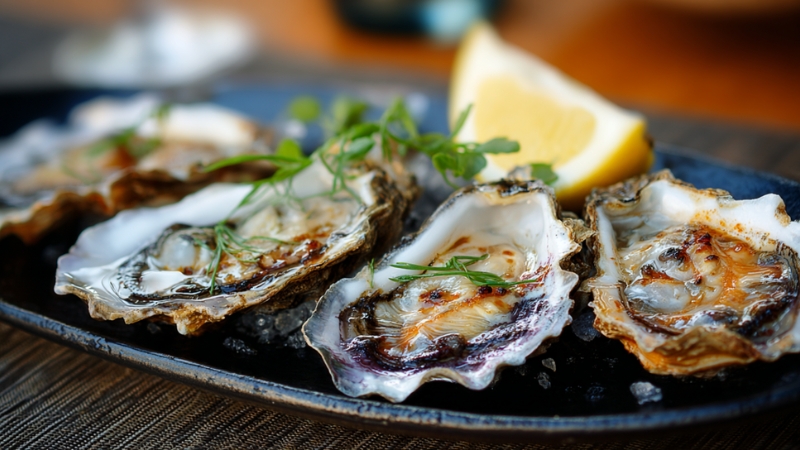
The flavor isn’t the only thing that changes from coast to coast. The look, feel, and physical structure of the oysters vary in ways that affect how they’re eaten and appreciated.
East Coast Shells Are Petite and Refined
East Coast oysters tend to stay on the smaller side. They grow slower in the colder waters, which limits their overall size but boosts flavor concentration.
- Beau Soleil (Louisiana): Around 2½ inches.
- Naked Cowboy (Long Island): Roughly 3 inches.
Their shape leans toward teardrop or oval, with smooth, less ridged shells. The cups are shallow, which means less liquor (the briny oyster juice inside) but an easy, clean bite.
They look elegant on a half-shell plate and are simple to slurp.
West Coast Shells Are Big, Bold, and Beautifully Fluted
On the Pacific side, you’ll often see oysters with deeper cups and a rounder, more rugged shape.
- Hammersley (Washington): Can reach 4 inches.
- Fanny Bay (British Columbia): Generally around 3 inches.
The fluted, ruffled edges make them look wilder and more dramatic. The deeper cups help hold more liquor, giving a fuller flavor experience when eaten raw.
| Aspect | East Coast | West Coast |
| Flavor | Briny, salty, savory with mineral notes | Sweet, creamy, cucumber or melon flavors |
| Salinity | High | Moderate |
| Size | Smaller (2½-3 inches) | Larger (3-4 inches) |
| Shell Shape | Teardrop, smooth, shallow cup | Round, ruffled, deep cup |
| Texture | Firm and chewy | Silky, soft, sometimes buttery |
Why New York Wins
@madelinethekitchen My favorite place to get oysters 🦪🦪 @Lobster Place #oysters #shellfish #lobster #seafood #nyc #dinner #food #recipes #recipe #fyp #fypシ #fypシ゚viral ♬ original sound – Madelinethekitchen
There’s a reason chefs and oyster bars across the country seek out New York oysters. It’s not just pride. New York oysters combine the best elements of East Coast brininess with a rich cultural story and ideal growing conditions.
Legendary Varieties
New York doesn’t just produce oysters – it produces icons. The names alone have become shorthand for quality in raw bars from Brooklyn to Berkeley.
- Blue Point (Great South Bay): Round, firm, slightly salty with a buttery finish. Excellent for beginners and connoisseurs alike.
- Naked Cowboy (Long Island): Dense, briny, and minerally – perfect for people who like a big flavor.
- Fishers Island: Balanced, with a classic brine and elegant shell.
- Montauk Pearl: Bold flavor with a dense texture and briny finish.
Each one reflects a distinct patch of water around Long Island, giving you a tour of the region without leaving your seat.
A Deep Culinary History
Food for thought: Oysters were once so popular in NYC, the shells were used to pave Pearl Street. #knowNY https://t.co/kV9s56Xehr pic.twitter.com/v7B8B5Mtan
— NYPL History & Genealogy (@NYPLHistory) December 10, 2020
New York’s connection to oysters goes way back. In the 1800s, oysters were a staple food, not a luxury item. People ate them by the dozen, sometimes more than 600 per person in a single year.
Blue Points were sold fresh on Mulberry Street, and oyster cellars were as common as coffee shops are today. That history still lingers in the city’s culture.
Walk into any serious raw bar in Manhattan or Brooklyn, and you’ll see multiple East Coast varieties, with New York oysters taking center stage. It’s part tradition, part quality.
Cleaner Waters, Stronger Future
There’s also a sustainability story worth mentioning. The Billion Oyster Project, launched in 2014, is restoring oyster reefs in New York Harbor. These reefs not only support oyster populations but also clean the surrounding waters and stabilize the shoreline.
One oyster can filter up to 50 gallons of water per day. That matters, not just for ecology, but for flavor. Cleaner water equals better oysters, and the ongoing restoration efforts are giving New York oysters a long-term edge in both quality and consistency.
Better Flavor Through Patience
New York oysters take their time to grow, often reaching maturity in three to four years. The longer growth cycle, powered by colder water and nutrient-rich tides, builds complexity into the meat.
You don’t get that from faster-growing Pacific oysters, which tend to top out at 18 to 24 months. The payoff is noticeable.
There’s more going on with each bite – a wave of brine followed by subtle earthiness, a hint of mineral, sometimes a buttery or woody finish depending on the variety.
| Feature | New York Oysters | Other Notable Varieties |
| Top Varieties | Blue Point, Naked Cowboy, Fishers Island | Kumamoto (West), Wellfleet (East) |
| Flavor | Briny, complex, savory, mineral | Sweet (Kumamoto), balanced brine (Wellfleet) |
| Size & Shape | 3-4 inches, teardrop or round | Varies from 1-4 inches, various shell shapes |
| Cultural Importance | Deep historical roots, urban tradition | Varies by region |
| Sustainability Efforts | Billion Oyster Project | Various, less centralized |
Enjoying Oysters Like a Pro
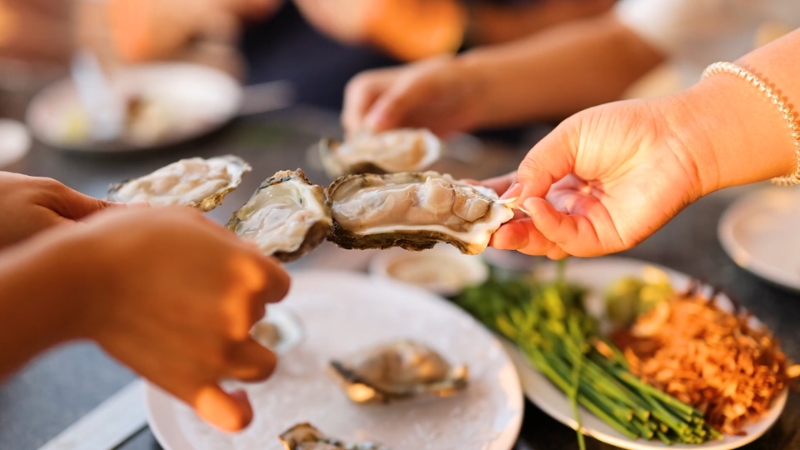
Whether you’re new to oysters or a longtime fan, how you eat them can shape the whole experience. Choosing the right pairing and preparation helps each oyster shine.
East Coast Pairings
Their sharp brine and bold flavors pair well with:
- Dry white wines: Muscadet, Chablis, Champagne
- Cider or dry stout: The clean acidity and crisp finish cut through the salt
- Mignonette: A vinegar-shallot sauce enhances their minerality
- Lemon or hot sauce: Use sparingly to avoid masking the flavor
West Coast Pairings
Their soft, sweet notes go best with:
- Fruit-forward wines: Sauvignon Blanc, Grüner Veltliner
- Dry sake or rosé: Something light and subtle
- Cucumber mignonette or yuzu ponzu: Adds brightness without overpowering
- No condiment at all: Let the creaminess speak for itself
Tasting Tips
- Always start with a plain oyster before adding toppings.
- Don’t overdo it. Try four to six varieties in a session to keep your palate fresh.
- Ask for local recommendations. Raw bar staff often know what’s peaking in flavor.
Final Thoughts
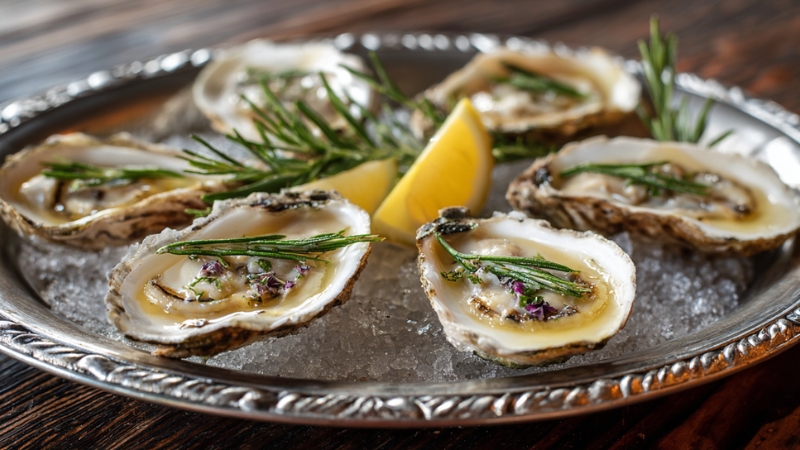
The oyster world isn’t just split between coasts – it’s filled with nuance. East Coast oysters bring bold salt and flavor complexity that feels like a direct shot of the ocean. West Coast oysters are leaner, softer, sweeter, and more delicate.
Both have something to offer, but if you want deep flavor, a rich history, and world-class quality, New York oysters are where it’s at.
Whether you’re reaching for a briny Naked Cowboy in Manhattan or sipping wine beside a platter of Kumamotos in San Francisco, you’re tapping into one of the oldest, most refined seafood traditions around.
And once you’ve tasted enough to know what you like, the ocean’s wide open.
